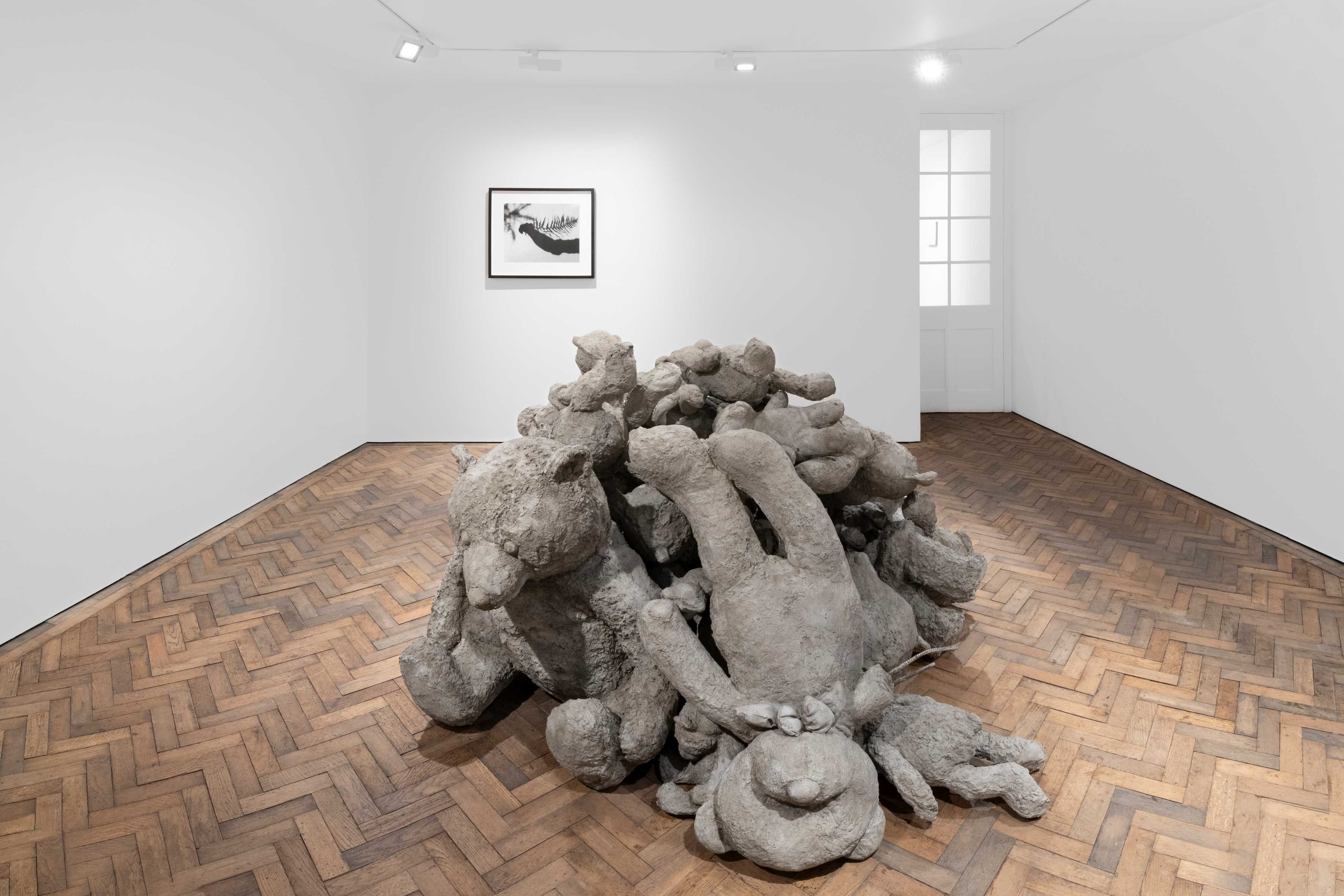


Josh Kline, Indifference, 2017 polymerized gypsum, sand, gravel, urethane foam, steel, and acrylic, courtesy the artist and Modern Art
Modern Art, Bury Street, 7 Bury St, St. James's, London SW1Y 6AB
19 April – 18 May 2024
We are fast approaching the season of the ‘summer group show’ which takes place in various cities across the world, riding on the tailwind of events such as the Venice Biennale, Glasgow International and Frieze New York. In Modern Art on Bury Street, the curatorial approach to conceptualising a group show is distinct and refreshing – resisting any prescriptive theme or commonality beyond the simple fact that the artists featured are all represented by the gallery (and owning this decision with quiet confidence). This melting pot of culminating artists and artworks reminds me of visits to my childhood home, re-discovering items in my old bedroom that evoke specific recollections, nostalgic or otherwise. The show itself covertly mirrors these feelings through its staging and conceptual rigour, though at points in a more humorous or dystopian manner. These aren’t new works on display, rather, former pieces that the gallery has re-staged, in many ways emphasising the coded and clandestine memories and connections that arise in response to an object, whether it’s an old toy, game, ornament or in this case a work of art.
Beginning downstairs you’ll find artworks that resonate a suburban soporism, implying a post-apocalyptic scene that is laden with detritus. This is most notable through the work of Josh Kline. Kline's large-scale sculpture weightily sits in the middle of the basement space and consists of concrete-like teddy bears heaped in a pile – much like a plushie pile one might find in the corner of a child’s bedroom. These bears feel like a relic from a distant past, tracing civilization and the remnants of global commerce through a hardened and antithetical cuteness. Continuing this theme on the wall is a 3D printed bronze action figurine by Yngve Holen, encompassing cyborg pop-culture aesthetics, a hybrid crocodile-transformer yields an ornate futuristic axe that protrudes from the wall at head height. Holen examines product marketing strategies employed by global corporations, in this case a line of products titled ‘The Legends of China’, which consists of seven different cyborg animals with distinct capabilities and introduced to the market by LEGO in 2013 (but discontinued by 2015). An overarching question in Holen’s work asks us what kind of concepts and technologies are introduced to children, particularly during the formative years of their neurological development and how such products influence their understanding of the world around them.
Operating on a different plane upstairs is a sculptural installation laid out on the floor by Philip Lai. This work is a re-staging from a past solo show at Camden Art Centre which focused on notions of belonging and containment through a controlled and formalised process. Hollow cylindrical vessels rest and balance on plexiglass, which in turn are laid on top of a large black rubber mat. These objects, whilst at first vaguely recognisable, become abstracted through the approximate detailing in their manufacture. The precision, accuracy and tolerance involved in the creation of this work can be ontologically traced to processes employed by the Pharaohs, signalling the historical symbiosis that has existed between technology and craft for over two millennia and emphasising Lai’s fascination with the material world and its anthropological genealogy.
Glancing at the wall I am drawn to a small, discreet work by Sarah Rapson which, at a distance, feels visually akin to the legacies of minimalist painting and yet on closer inspection carries the weight, critique and introspection of art history in an apathetic and humorous albeit tender fashion. An oblong canvas is covered in yellowing newspaper clippings that feature art reviews and articles spliced together to create a litany of art criticism and market spiel. It’s reminiscent of a critical Pinterest board that laments the early, hopeful and at points tragically funny aspirations held by hopeful emerging artists in amongst the ghosts of the artworld. Rapsons dissection of critical literature ultimately highlights art world provenance, current affairs and social commentaries – to which she herself recluses away, living down by the southwest coast of England and freely embracing the liminal space between insider and outsider artmaking.
Across from Rapson are two wall works by the late Pope.L featuring text paintings that intimately capture moments of fragmented poesis. Loaded in their subject matter and delivery, these statements, descriptions, proclamations and accusations intermingle with layers of paint, washes of colour and scrubbed out lettering. For these works in particular the text briefly alludes to a black town, fields, homes, a convenience store owned by Italians and driving through a nondescript place toward the woods, the question remains as to whose home, what destination and why. The text circumvents the standardised syntax of language to create an ellipsis of disjointed introspection. Pope.L grew up in a household filled with poetry and was encouraged to be playful with the binary parameters of language early on in life having started text paintings whilst at college in the 1970s.
Whilst the works vary considerably, Modern Art has taken the concept of the group show and cleverly reformulated it by not prescribing or forcing any one particular theme. As such the viewer is left to freely interpret (or not) how these artworks generate aleatoric conversations. They are given the space and breadth to operate autonomously, free from the shackles of a press release. Personally, it feels like diving into a treasure-trove or toybox and rediscovering items from a past, unearthing memories or histories that might evoke a sense of nostalgia, introspection, humour, apathy or even unease all of which feel particularly apt as the London group summer shows draw nearer.
Jordan Mouzouris
Curator, Digital
Group Show at Modern Art, Bury Street, 7 Bury St, St. James's, London SW1Y 6AB
19 April – 18 May 2024, gallery opening hours: 11am to 6pm.